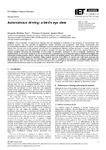Autonomous driving: a bird's eye view

Use este enlace para citar
http://hdl.handle.net/2183/22296
Excepto si se señala otra cosa, la licencia del ítem se describe como Atribución-NoComercial-SinDerivadas 3.0 España
Colecciones
- Investigación (ETSECCP) [826]
Metadatos
Mostrar el registro completo del ítemTítulo
Autonomous driving: a bird's eye viewFecha
2019Cita bibliográfica
Martínez-Díaz, M.; Soriguera, F.; Pérez, I. Autonomous driving: a bird's eye view. IET Intelligent Transport Systems 2019, 13 (4), p. 563-579
Resumen
[Abstract:] The introduction of autonomous vehicles (AV) will represent a milestone in the evolution of transportation and personal mobility. AVs are expected to significantly reduce accidents and congestion, while being economically and environmentally beneficial. However, many challenges must be overcome before reaching this ideal scenario. This study, which results from on-site visits to top research centres and a comprehensive literature review, provides an overall state-of-the-practice on the subject and identifies critical issues to succeed. For example, although most of the required technology is already available, ensuring the robustness of AVs under all boundary conditions is still a challenge. Additionally, the implementation of AVs must contribute to the environmental sustainability by promoting the usage of alternative energies and sustainable mobility patterns. Electric vehicles and sharing systems are suitable options, although both require some refinement to incentivise a broader range of customers. Other aspects could be more difficult to resolve and might even postpone the generalisation of automated driving. For instance, there is a need for cooperation and management strategies geared towards traffic efficiency. Also, for transportation and land-use planning to avoid negative territorial and economic impacts. Above all, safe and ethical behaviour rules must be agreed upon before AVs hit the road.
Palabras clave
Road accidents
Road safety
Sustainable development
Road vehicles
Mobile robots
Electric vehicle
Autonomous vehicle
Vehículos autónomos
Vehicle technology
Tecnología del vehículo
Cooperative driving
Conducción cooperativa
Traffic efficiency
Eficiencia del tráfico
Vehicle automation impacts
Impactos de la automatización del vehículo
Road safety
Sustainable development
Road vehicles
Mobile robots
Electric vehicle
Autonomous vehicle
Vehículos autónomos
Vehicle technology
Tecnología del vehículo
Cooperative driving
Conducción cooperativa
Traffic efficiency
Eficiencia del tráfico
Vehicle automation impacts
Impactos de la automatización del vehículo
Versión del editor
Derechos
Atribución-NoComercial-SinDerivadas 3.0 España
Ítems relacionados
Mostrando ítems relacionados por Título, autor o materia.
-
Autonomous vehicles: theoretical and practical challenges
Martínez-Díaz, Margarita; Soriguera, Francesc (Elsevier, 2018)[Abstract:] Autonomous driving is expected to revolutionize road traffic attenuating current externalities, especially accidents and congestion. Carmakers, researchers and administrations have been working on autonomous ... -
Coordinación UAV-UGV para tareas de Búsqueda y Rescate
Rodríguez Palafox, Pablo; Garzón Oviedo, Mario; Barrientos, Antonio (Comité Español de Automática, 2016)[Resumen] Se presenta un sistema autónomo de Búsqueda y Rescate basado en la coordinación entre un UAV y un UGV (este último funcionando como plataforma móvil de aterrizaje). El vehículo aéreo debe localizar el objetivo ... -
Entorno de simulación de vehículos no tripulados y sensores marinos
Quesada Conejero, Víctor; Capitán, Jesús; Rodríguez Castaño, Ángel (Universidade da Coruña. Servizo de Publicacións, 2023)[Resumen] Existe un creciente interés en el empleo de embarcaciones no tripuladas, comúnmente denominadas USVs (Unmanned Surface Vessel/Vehicles). Dado el coste económico y complejidad de experimentar con embarcaciones ...






